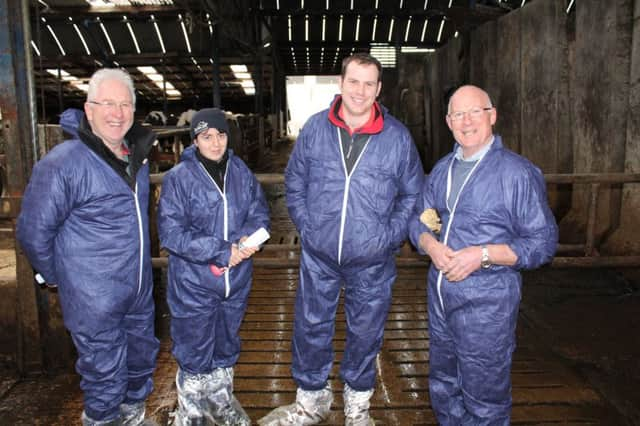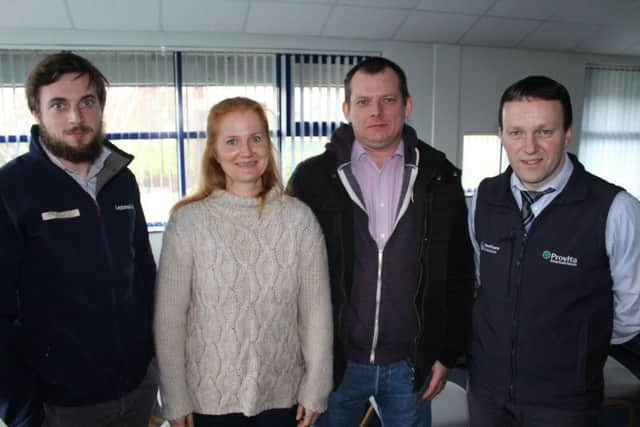Lameness control must start with heifer


The world renowned lameness specialist spoke at a number of seminars and workshops, hosted by Provita, Moore Concrete and Barclay’s Bank earlier this week.
“Lameness prevention strategies must be implemented at the heifer stage,” he explained.
Advertisement
Hide AdAdvertisement
Hide Ad“And this entails regular footbathing and early intervention when lameness problems are identified.


“Heifers carrying the bacteria that cause digital dermatitis are active sources of infection for milking cows, once these younger animals enter the dairy herd proper. The same principle also holds where dry cows are concerned. Hence the need to regularly footbath these animals as well.”
Mr Blowey confirmed a direct link between body condition score and an animal’s predisposition to lameness-related problems.
“Lame cows go thin: but thin cows also go lame,” he said.
“Animals that lose weight after calving have double the risk of going lame. This is because they have thinner fat pads. Fat pads are the part of the hoof that absorb shocks between the hoof and the pedal bone. And, of course, heifers are most likely to lose condition after calving. So a transition group will help reduce stresses on freshly calved cows and heifers.”
Advertisement
Hide AdAdvertisement
Hide Ad

Mr Blowey said that scientists are still working to identify how digital dermatitis is spread form animal to animal.
“Believe it or not, the bacteria are rarely found in slurry. However it has now been found under fresh foot prints left by cows. So footbathing during milking and when handling, e.g. testing and trimming will help reduce the risk of spreading the bacteria.
“We also found it on latex gloves and the tools used for hoof trimming after an infected animal has been handled.
“Although we do not know if there is enough DD bacteria on the gloves to actually cause the disease, it must be a sensible measure to regularly disinfect hands and equipment, especially after dealing with badly infected animals.
Advertisement
Hide AdAdvertisement
Hide Ad“Most importantly good hygiene and regular footbathing of all groups especially the heifers will help control lameness.
“DD is like mastitis of the feet, so footbathing should be used to prevent DD.”
Courtesy of his presentation, Provita’s Tommy Armstrong confirmed that lameness problems are costing dairy farmers in Northern Ireland £9,800, on-average, per year.
“This is for a producer with 100 cows,” he said. “But the reality is that a daily footbathing programme will pay for itself many times over on an annual basis. This assumes that a 75% control rate is achieved and that footbathing is done year around.
Advertisement
Hide AdAdvertisement
Hide Ad“Hoofsure Endurance is the most widely researched and cost effective proven alternative to Copper Sulphate and Formalin that is compliant with biocides regulations. However footbaths need to be used at right dilution rate, right depth and every day, we now have the DDApp and Hoofsure HELP service which are free to use services that will help ensure all these things are done right.”
Another factor identified by hooftrimmers present at the meeting was the fact they had seen a huge increase in calls relating to foul and digital dermatitis over the last month, relating to slurry tanks being almost full. This has been highlighted in recent research as a big risk factor in terms of lameness.
Moore Concrete’s Jeff Haslett discussed the company’s footbath range and the success of its Sure-Foot slat range.
“We manufacture baths on a bespoke basis,” he said.
“Increasingly, farmers are keen to have baths designed that will fit directly adjacent to the water troughs in their sheds.
Advertisement
Hide AdAdvertisement
Hide Ad“This allows cows to stand in the active solution while drinking. It also allows the baths to be that more easily filled by simply taking out the bung in the nearby trough.”
Mr Haslett confirmed a growing demand for the Sure-Foot slat range, which had been specifically developed to reduce the number of slippages and falls incurred by cows and other cattle.
“The benefits the slats offer, compared to non-brush options, work out at £60 per cow per year. This figure takes accounts of reduced culling rates, due to animals slipping, a reduced level of lameness and a reduction in calving interval. These figures were independently assessed,” he explained.
Barclay’s James Trotman said that, with interest rates at historically low levels, now was a good time for farmers to borrow money.
Advertisement
Hide AdAdvertisement
Hide Ad“Fixed interest deals on finance for up to 10 years are currently available. But the driver for all farming businesses ahead is that of becoming more efficient,” he added.
“Brexit will bring with it a number of uncertainties, one of which is the level of support that will be available to agriculture beyond 2020.
“So farmers must be looking at the feasibility of operating their businesses without any form of support safety net at all.”
Mr Trotman pointed out that producers must always think in terms of the margins they generate: not yields.
“Having a firm knowledge of production costs is also crucially important,” he said.
“And the same principle holds where cash flows are concerned.”